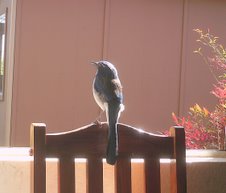I found this article interesting. The study of the Western Scrub Jay's ability to plan and have an understanding of time. Although not all experts agree, it is now an accepted theory.
I have witnessed Blue and his nut hiding abilities for years. If the study did not take into account the season, the weather, and many other factors, I find it hard to believe it was a very accurate study. It only took three days. Read for yourself and let us know what you think about this study. Can Blue plan for the future? Only primates and humans are supposed have this ability, but I never belived that. Dolphins have saved humans from sharks. Dogs have traveled hundreds of miles to find there way home. Maybe we are just too hung up about being above animals to change our persception of how they think. Maybe the are not void of intelect.
By Joe Eaton
Nicola Clayton and her scrub-jays have been at it again. Clayton, as you may recall, is the Cambridge experimental psychologist who keeps making startling claims about the cognitive abilities of the western scrub-jay, a bird she met while at UC Davis. (It’s the most widespread of three closely related species of crestless blue-and-gray jays; the others, the Florida scrub-jay and island scrub-jay, have limited ranges).
It was Clayton who contended that scrub-jays demonstrated episodic-like memory, thought to be a human exclusive: they could recall what they had done where and when, specifically where they had stashed perishable waxworms and more durable peanuts. In the wild, the birds cache and retrieve acorns. They’re not as good at re-finding stored food as their corvid relatives the pinyon jay and the Clark’s nutcracker; as Joseph Grinnell observed back in 1936, the acorns the scrub-jays miss may become the next generation of oaks.
It was also Clayton who found evidence for a “theory of mind” in scrub-jays, the ability to think of what others might be thinking. In that case, jays prone to pilfering other birds’ caches returned to move food that they had been observed hiding. The line of thought would be: “If I had seen Ralph hiding that acorn, I’d go steal it; and since he saw me hiding mine…”
Critics objected to both claims, of course, but Clayton’s ingenious experiments made a strong case. Now she’s back, in a recent issue of Nature, with a new study that suggests scrub-jays can plan for the future—again, something only the higher primates, humans and great apes, were supposed to be able to do.
Granted, many animals do things that appear purposeful: they fly north for the spring and south for the winter, swim to Ascension to mate, seek out caves or dens for hibernation, store acorns. But it’s assumed these behaviors are hardwired responses to seasonal cues: the animals are programmed to act in pre-set ways with changes in temperature or daylight.
With Clayton’s jays, something different seems to be going on. Her experiment this time exploited the birds’ caching compulsion.
She designed a three-chambered setup. The jays were kept overnight in the central space, with powdered pine nuts to snack on. In the morning they were moved into one of two adjoining spaces, one with food, the other without.
On their second night in the experimental cages, the jays were given a supply of pine nuts and each side room had a sand-filled ice-cube tray for caching. The birds that had previously missed out on breakfast cached three times as many nuts in the “no-breakfast room” as in the “breakfast room.” They seemed to remember whether they had spent the previous morning in a cozy B & B or in a Motel 6.
What could this be, asks Clayton, but a kind of mental time travel?

No comments:
Post a Comment